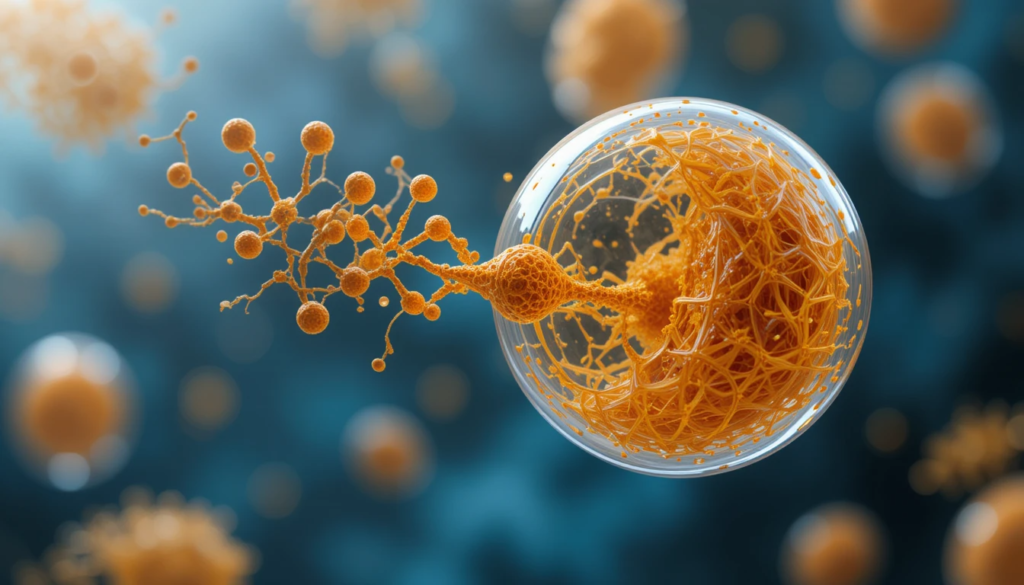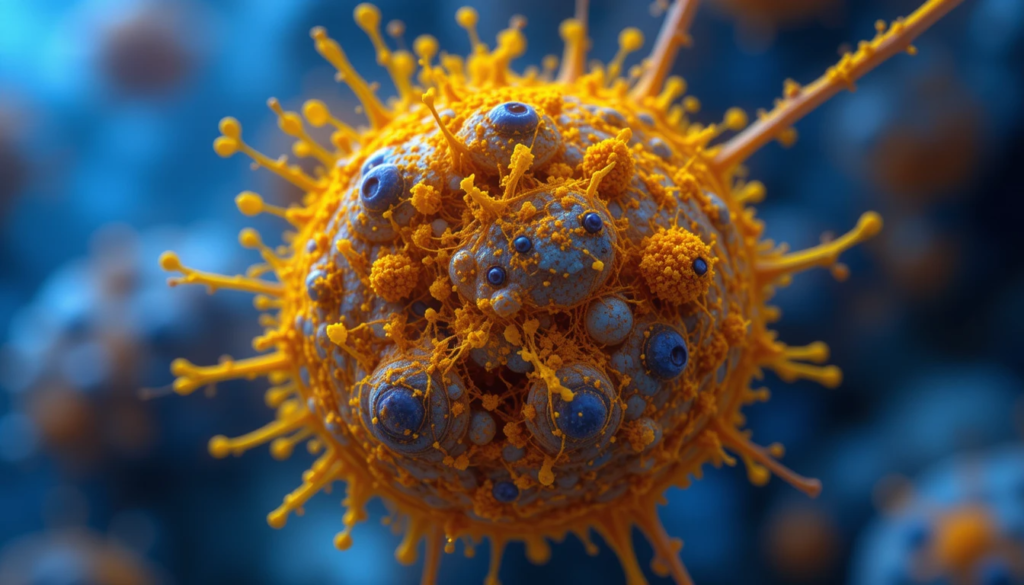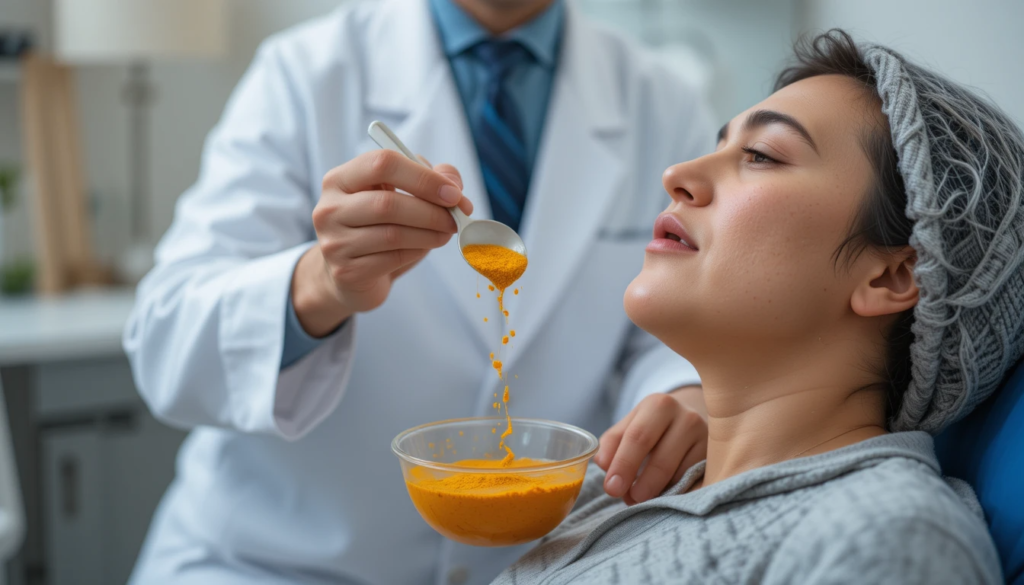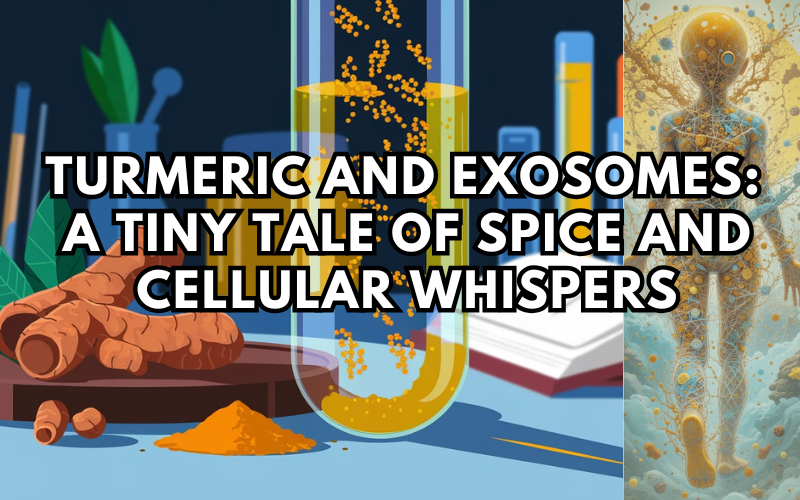Turmeric, that golden-hued spice gracing your curries and lattes, isn’t just a culinary superstar. It’s also a treasure trove of health benefits, thanks to its key ingredient, curcumin1. But here’s the twist in our story: curcumin, in its natural form, is a bit of a diva. It’s unstable, breaks down quickly in the body, and doesn’t always play well with our cells1. So, how do we unlock its full potential?Enter exosomes – the tiny messengers of our cells. Think of them as miniature, biological couriers, delivering precious cargo from one cell to another1. And guess what? Scientists are discovering that exosomes and turmeric might just be the dynamic duo we’ve been waiting for3.

The Curcumin Conundrum: A Spice with a Secret
Curcumin, the star of turmeric, boasts a resume that would make any superfood jealous. It’s an anti-inflammatory agent, an antioxidant powerhouse, and even has anti-cancer properties13. But there’s a catch. Curcumin’s “bioavailability” – its ability to be absorbed and used by the body – is notoriously low3. It’s like trying to send a text message with a weak signal; the message (or in this case, curcumin) gets lost in translation1.Researchers have been scratching their heads for years, trying to figure out how to boost curcumin’s effectiveness. Encapsulation, the process of wrapping curcumin in protective packages, seemed promising. Scientists tried using polymers and liposomes, but something was still missing3.

Exosomes: Nature’s Delivery Service
Then came exosomes, those tiny vesicles secreted by our cells. Exosomes are like miniature envelopes filled with proteins, lipids, and genetic material1. They’re used for cell-to-cell communication, ferrying messages and instructions throughout the body1.What if, researchers wondered, we could harness these natural delivery vehicles to transport curcumin? It was a eureka moment, like discovering that your postal carrier can also brew a perfect cup of coffee.
The Magic of Encapsulation: Exosomes to the Rescue

The idea was simple: load curcumin into exosomes and let them do the heavy lifting1. By encapsulating curcumin in exosomes, scientists hoped to improve its stability, solubility, and bioavailability3. The result? A souped-up version of curcumin that could finally reach its full therapeutic potential3.
How It Works: A Cellular Symphony
Here’s the beautiful part: exosomes aren’t just any delivery service; they’re targeted delivery experts4. They’re drawn to specific cells and tissues, ensuring that curcumin reaches its intended destination4. It’s like having a GPS for your spice!Moreover, exosomes protect curcumin from breaking down in the harsh environment of the body1. They shield it from degradation, allowing it to circulate longer and exert its beneficial effects1. It’s like giving curcumin a tiny, armored car for its journey through the bloodstream.
Turmeric-Derived Exosomes: The Plant-Powered Approach
But the story doesn’t end there. Researchers have taken the concept a step further by isolating exosome-like nanoparticles directly from turmeric2. These turmeric-derived nanovesicles (TNVs) are like tiny packages naturally loaded with curcumin and other beneficial compounds2.

The Fresh Herb Advantage
These plant-derived exosomes have several advantages. First, they’re natural and biocompatible, meaning they’re less likely to cause adverse reactions2. Second, they can be easily produced from fresh turmeric, which contains a wealth of bioactive molecules2. It’s like getting your medicine straight from Mother Nature’s pharmacy!
Promising Applications: From Gut Health to Brain Boost
So, what can we expect from this turmeric-exosome dream team? The possibilities are vast and exciting1.

Taming Ulcerative Colitis
One promising application is in the treatment of ulcerative colitis (UC), a chronic inflammatory bowel disease2. TNVs have shown potential in alleviating colitis by targeting damaged intestinal barriers, restoring balance to the gut microbiota, and regulating the immune response2. It’s like sending a SWAT team of tiny turmeric soldiers to quell the inflammation in your gut.
Fighting Inflammation
Turmeric-derived nanoparticles have also demonstrated anti-inflammatory and antioxidant effects in models of acute inflammation3. By delivering curcumin directly to inflamed tissues, exosomes can help reduce swelling, pain, and cellular damage3.
Conquering Cancer

But wait, there’s more! Curcumin-encapsulated exosomes have shown enhanced anti-proliferative activity against multiple cancer cell lines1. By delivering curcumin directly to cancer cells, exosomes can help inhibit their growth and spread. It’s like a tiny, targeted missile striking at the heart of the tumor.
Boosting Brainpower
Curcumin-primed exosomes – exosomes pre-treated with curcumin – can even protect brain cells and relieve symptoms of Alzheimer’s disease4. By enhancing the delivery of curcumin to the brain, these exosomes can help prevent neuronal death and improve cognitive function4.
The Future is Golden: What’s Next for Turmeric and Exosomes
The research on turmeric and exosomes is still in its early stages, but the results are promising. Scientists are exploring new ways to harness this dynamic duo for a variety of therapeutic applications1.
Microneedle Delivery

One innovative approach involves using microneedles to deliver curcumin-loaded exosomes directly to the skin1. This method could revolutionize the treatment of skin inflammation, cancer, and other dermatological conditions1.
Targeting Specific Diseases
Researchers are also working to develop exosomes that target specific diseases and tissues1. By engineering exosomes to recognize specific markers on cancer cells or inflamed tissues, scientists can create highly targeted therapies that minimize side effects1.
A Word of Caution: Not All Spices are Created Equal


Before you start swallowing spoonfuls of turmeric in hopes of boosting your exosome activity, it’s important to remember that more research is needed1. The optimal dose and delivery method for turmeric-exosome therapies are still being investigated1.It’s important to consult with a healthcare professional before making any drastic changes to your diet or supplement regimen1. While turmeric is generally safe, excessive intake can cause side effects in some individuals.
The Takeaway: Embrace the Potential, Proceed with Caution
Turmeric and exosomes may seem like an unlikely pair, but together, they represent a powerful force in the world of medicine3. By harnessing the natural delivery capabilities of exosomes, scientists are unlocking the full therapeutic potential of curcumin and other plant-based compounds3.As research continues to unfold, we can expect to see even more innovative applications of this golden spice and its tiny cellular partners. So, go ahead and sprinkle some turmeric on your eggs, but remember that the real magic lies in the science that’s just beginning to reveal its secrets1.Citations:
- Microneedles unlock curcumin’s therapeutic potential1
- Turmeric-derived nanovesicles as novel nanobiologics for …2
- Exosomal curcumin: its bioavailability and potential anti3
- Curcumin-primed and curcumin-loaded exosomes4
- Extraction, Isolation, and Component Analysis of Turmeric-…5
- Therapeutic use of curcumin‐encapsulated and …6




